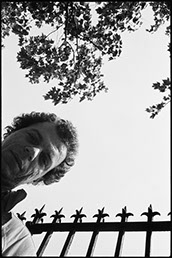>
DENIS MALARTRE
ACCUEIL / HOMEPAGE
PHOTOGRAPHIES
AUTRES / OTHER WORKS
ÉCRITS / WRITINGS
ABOUT THE OBJECTALES (I)
>
ABOUT THE OBJECTALES (II)
FLY-PAPER
BIOGRAPHIE
CONTACT
ABOUT THE OBJECTALES (II)
1986
Self-portrait, NYC - 1986
The photographic adventure that started during the Renaissance must come to an end. The perspective system oriented from the outside to the inside—a monocular contemplation of a well-ordered, hierarchical, three-dimensional world—becomes tedious and in the end, obsessive: a repetition of the prevailing vision, a perception that is continually starting over again but never coming to a conclusive end.
Why is it that photography doesn’t question itself? Why does it take reality at face value? Granted, common and artistic practices have caused confusion, mixing representation with reality, confounding the mental image with the real world. As we know, photography has liberated painting from perspective, from its representative (realistic) role, and given it free rein to question its very nature, its ideology, the philosophical world of the surface. In the same way, today’s television should free the photographic image from the grip of documentary, from the journalistic eye, from the factual. And very slowly, photography is dying, suffocated by millions of images, all similar, all subjected to that tiny window on the world. Photographers have had their day. Driven by the machine, they have gone to the extreme in complicating the laws of composition, led by Cartier-Bresson down the path to accidents, to mundane incidents, to a glorification of the street, the banal.
Ever since this revolution, the world and its magnificent lights have encumbered light-sensitive surfaces. We remain stupefied before these piles of paper, bearers of so much love and hate, of so very many stories that one day they were bound to be merged with the real world, an illustration, superb and exact, of everyday suffering. We’ve seen it all, from the Spanish Civil War to Vietnam, from Moscow to New York or Tokyo. Each day the whole world comes to us, today like yesterday or tomorrow, the same world each day. Dazzling, hallucinatory visions, so much energy spent, to see only a tiny piece of the picture, through a keyhole, a crack in the window.
What imperious intellect is behind this enormous eye? How can a photographer find his own way, his individuality, his singularity? Each of us searches for his pertinence, his own eye. For one it’s zoos, for another gypsies, or monsters, or wars, or pilgrimages. Or wide angles, black and white, grainy images. Or putting the subject at the center of the frame, or at the edge. More or less necessity, skill, savoir-faire, or even genius, to produce an image, the same image. The photographer seeks, sometimes successfully, to slip his individuality into the mechanical image. Proving that it could be done. Yes, the world has something to do with fiction (Arbus, Frank). Approaches differ subtly, by their humanity, their tenderness or toughness, their sensitivity— all hazy, autobiographical notions. The affirmation of self behind the shutter seems like a tour de force, like a magic trick, the vibrant sensation of the decisive moment established as an irrevocable principle. And then came the multiplication of the loaves and the fishes. The depiction of the world became too distinct, too monotonous.
As I rest my elbow on these millions of images, I wonder what any of this has to do with me, this reality (photographic or not), these narcissistic biographies, these unchecked, repetitive narratives. Are we obliged to stay chained to this model, these frames, these photo mounts (another window on the window) and passively contemplate? Yet, it’s just a gelatine silver paper, a plain surface. So, the paper’s surface creates an illusion? Why continue this deception? I know that it is hard to entirely ignore the fact that an image is an image, but what remains, beyond the verisimilitude, is the illusion of perception, the self-deception. The object is there, in front of our eyes (as I said before, a piece of paper). Must we consider it as actual depth? This paper, made of space, of light, this paper composed of narrative and desire, summarizes the world’s complexities and contortions without clarifying anything. Everyone pushes and shoves, and in the end, falls under the spell of non-sense, of mannerism. We are blinded, held in the grip of this desire so fragile that satisfaction rarely crowns an image, that dissatisfaction is the principle that drives us towards repetition, towards starting over again in search of perfection, the ultimate achievement…a quest that always ends in disappointment.
We must reconsider these problems from the start and think (not by writing but by doing; pictorial thinking) about what constitutes an image. Take each step at its most basic, leaving aside all narrative and autobiographical considerations. I close the window so I can see better and I look at photography as an object. A sort of “objectal” relationship. Yes, that’s what it should be called: “objectal photography.” A whole new field opens up.
Take a shape…a simple shape. For example, a strip of white paper, a slightly irregular strip, not totally white. A simple photo of a shape. Facing the lens, in the centre of the frame. A single, plain light, creating values around the shape ranging from white to various shades of grey. A simple space. A minimal depth of field. An object, a barely perceptible depth that must be limited sometimes by manual intervention. Marks engraved in the gelatine to keep the space from running too far into the distance. A false flatness that reflects the paper object that is photography.
Well, it’s an example.
Denis Malartre
November 24, 1986
Translation: Margie Rynn
Version française
English version
✓